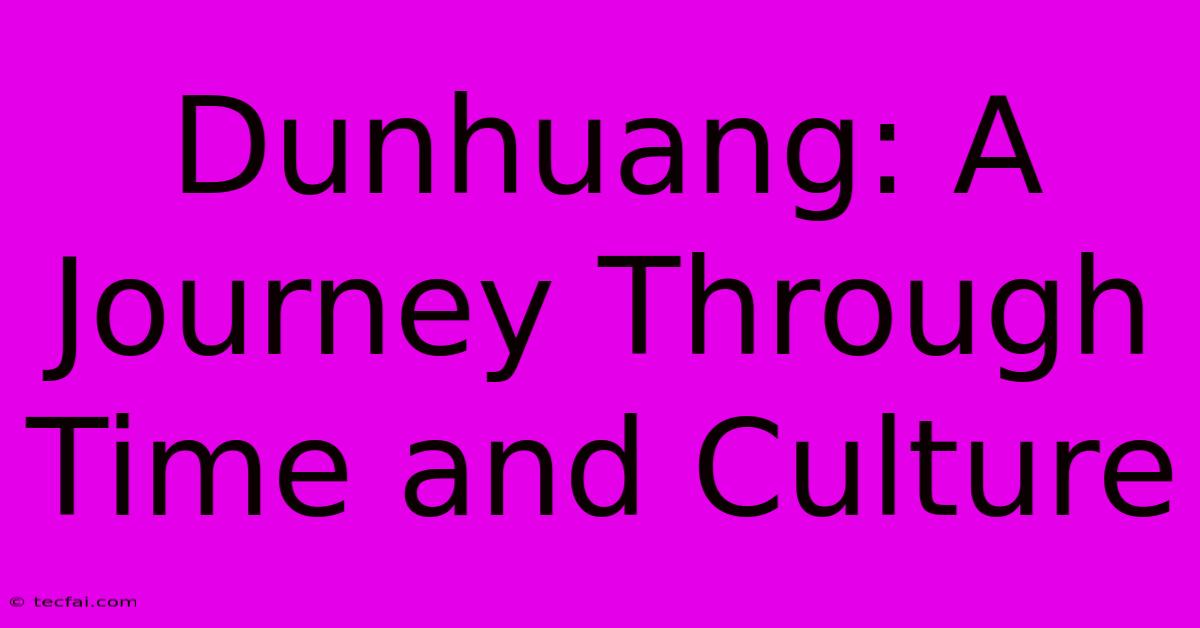Dunhuang: A Journey Through Time And Culture

Discover more detailed and exciting information on our website. Click the link below to start your adventure: Visit Best Website tecfai.com. Don't miss out!
Table of Contents
Dunhuang: A Journey Through Time and Culture
Nestled amidst the desolate Gobi Desert in northwestern China lies Dunhuang, a city steeped in history and culture. For centuries, this oasis city served as a vital crossroads on the ancient Silk Road, connecting the East and West through trade, cultural exchange, and the spread of religious ideas. Today, Dunhuang stands as a testament to this rich past, attracting travelers from all corners of the globe eager to experience its unique blend of ancient wonder and contemporary charm.
Exploring the Caves of Mogao: A Tapestry of Art and Faith
The most iconic landmark of Dunhuang is undoubtedly the Mogao Caves, a complex of 735 Buddhist cave temples carved into the cliffs of the Mingsha Mountain. This UNESCO World Heritage Site holds a treasure trove of ancient Buddhist art, spanning over a millennium from the 4th to the 14th centuries.
Inside the caves, you'll encounter:
- Magnificent murals: Covering the walls of the caves, these murals depict scenes from Buddhist scriptures, stories of the Buddha's life, and scenes from daily life during the Tang Dynasty. The vibrant colors, intricate details, and skillful craftsmanship of these murals are simply breathtaking.
- Exquisite statues: The caves are also home to numerous statues of Buddha and other Buddhist deities, crafted from a variety of materials, including clay, wood, and stone. Their serene expressions and intricate details are a testament to the artistic skill of the ancient artisans.
- Ancient scrolls and manuscripts: The Mogao Caves also house a vast collection of ancient scrolls and manuscripts, including Buddhist scriptures, historical records, and even love letters. These documents provide invaluable insights into the history and culture of the Silk Road.
Beyond the Caves: Unveiling Dunhuang's Cultural Heritage
While the Mogao Caves are undoubtedly the main attraction, Dunhuang offers much more than just ancient art. The city itself is a fascinating blend of historical sites, vibrant markets, and modern life.
Here are some other must-see attractions in Dunhuang:
- The Crescent Spring and Singing Sand Dunes: Just a short distance from the Mogao Caves, this stunning landscape features a crescent-shaped spring nestled at the foot of towering sand dunes. The dunes are known for their "singing" sound, a phenomenon caused by the wind blowing through the sand.
- The Dunhuang Academy: This museum houses a comprehensive collection of artifacts, including ancient scrolls, paintings, and sculptures, providing deeper insights into the history and culture of Dunhuang.
- The Silk Road Market: Experience the lively atmosphere of Dunhuang's local market, offering a wide variety of local crafts, souvenirs, and delicious local delicacies.
- The Giant Buddha Temple: This temple features a massive 35-meter-tall statue of Buddha carved into the cliffs of the Mingsha Mountain, offering a serene and contemplative experience.
A Journey Through Time: Understanding Dunhuang's Significance
Visiting Dunhuang is not just about exploring ancient sites and admiring artistic masterpieces; it's about understanding the historical significance of this city as a crossroads of cultures and ideas.
- The Silk Road: Dunhuang played a crucial role in the flourishing of the Silk Road, facilitating trade and cultural exchange between East and West. The city was a hub for merchants, travelers, and missionaries, who brought with them ideas, technologies, and religious practices from across the Eurasian continent.
- Buddhism in China: The Mogao Caves stand as a testament to the spread of Buddhism in China. These caves served as centers of religious study and pilgrimage, shaping the religious landscape of China for centuries.
- The Art of the Tang Dynasty: The Mogao Caves are a treasure trove of Tang Dynasty art, showcasing the height of Chinese artistic skill during this golden age. The murals and statues provide invaluable insights into the cultural and social life of the time.
Planning Your Journey to Dunhuang: A Gateway to the Past
Planning a trip to Dunhuang requires careful consideration, as the city is located in a remote and arid region. However, the rewards of exploring this unique cultural destination are truly worth the effort.
- Getting There: Dunhuang can be reached by air, with a well-connected airport serving major cities in China. Alternatively, you can take a train from nearby cities like Lanzhou or Xi'an.
- Accommodation: A variety of hotels and guesthouses are available in Dunhuang, catering to different budgets and preferences.
- Best Time to Visit: The best time to visit Dunhuang is during the spring or autumn when the weather is pleasant and the sandstorms are less frequent.
- Visa Requirements: Make sure to check the visa requirements for entering China before your trip.
Dunhuang: A Timeless Journey
A journey to Dunhuang is a unique and unforgettable experience that will transport you through time and immerse you in the rich tapestry of Chinese culture. From the ancient caves of Mogao to the vibrant markets of the city, Dunhuang offers a glimpse into a world that once connected the East and West, leaving an indelible mark on the history of the world.

Thank you for visiting our website wich cover about Dunhuang: A Journey Through Time And Culture . We hope the information provided has been useful to you. Feel free to contact us if you have any questions or need further assistance. See you next time and dont miss to bookmark.
Featured Posts
-
Man Arrested In Ballyfin Hotel Death Case
Nov 14, 2024
-
India Wins 3rd T20 I Tilak Varmas Century
Nov 14, 2024
-
Whoopi Goldbergs Finances Spark Backlash
Nov 14, 2024
-
Last Supermoon Of Four Next Full Moon Details
Nov 14, 2024
-
Whoopi Goldbergs Net Worth The View Hosts Wealth
Nov 14, 2024
